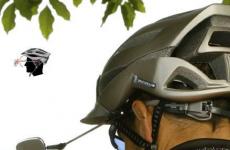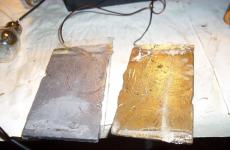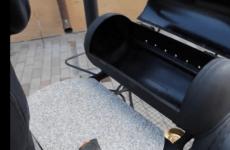Giving military honors at the burial of military personnel. Uniform of salute group
To escort the Battle Banner to the venue of the ceremonial meeting and back to the military unit, a banner platoon is assigned.
The removal and removal of the Battle Banner are carried out in accordance with the requirements of the Combat Charter of the Armed Forces of the Russian Federation.
giving away military honors at burial
338. Troops appointed to give military honors at burial constitute an honorary escort.
Honorary escort appointed at the burial of military personnel, citizens called up for military training, who died during the passage military service or died as a result of injury (injury, injury, concussion), disease; citizens dismissed from military service upon reaching the age limit for military service, for health reasons or in connection with organizational and staff measures, with a total duration of military service of 25 years or more; participants in the war, as well as citizens who had special merits before the state.
339. The organization of the funeral of military personnel who died (died) during military service is assigned to their direct superiors, and the rest of the persons, at whose burial an honorary escort is appointed, to the head of the garrison (city or district military commissar).
340. The honorary escort is appointed in the following composition:
At the burial of soldiers (sailors), sergeants (foremen), warrant officers (midshipmen) - a squad, platoon or a unit corresponding to them;
At the burial of officers, as well as military personnel and citizens awarded the title of Hero of the Soviet Union, Hero of the Russian Federation, awarded the Order of Glory of three degrees - a platoon, company or their corresponding unit.
During the burial of the deceased participants in the war in military ranks: private (sailor), sergeant (foreman), ensign (midshipman) and junior officers, based on organizational and staffing capabilities military units and their removal from the place of burial, an honorary escort is appointed as part of the department.
An honorary escort, appointed from a platoon or more, must be with the Banner without a cover and with a mourning ribbon.
341. In addition to the honorary escort, the following are appointed for the funeral:
Orchestra;
Guard of honor to the coffin;
Soldiers or sailors for lowering the coffin into the grave (8-10 people) without weapons under the command of a sergeant (foreman).
For the transportation of the coffin with the body of the deceased, a car or gun carriage is allocated.
To carry orders and medals, one person is appointed for each pad with an order or medals, and when officers are buried, officers are appointed for this, and when ensigns (midshipmen), sergeants (foremen) and soldiers (sailors) are buried, warrant officers (midshipmen), sergeants (foremen) or soldiers (sailors).
Each order is attached to a separate pad. Medals can be attached several on one pad.
A headdress is attached to the lid of the coffin, and for military personnel Navy(except for conscripts) and the dagger of the deceased.
342. An honorary escort and an order for the burial of a serviceman who died in his military unit are appointed by the commander of this unit. The military commander of the garrison is informed about the time and place of removal and burial of the body of the deceased.
In the event of the death of a serviceman outside the place of his permanent service, an honorary escort and funeral order are appointed by the head of the garrison at the place of death of the serviceman.
343. If the burial of a deceased soldier will take place in another city or village, the coffin with the body of the deceased is accompanied by an honorary escort and an orchestra to the city limits (station, airfield, port, pier).
To accompany the coffin with the body of the deceased on the way to the place of burial, by order of the commander of the military unit or the head of the garrison (military commissar), two to four people are appointed, who must be instructed and have with them: a notice of death; certificate and certificate of death; a letter to the family of the deceased, signed by the commander of the military unit, outlining the circumstances of death; own belongings, valuables and awards of the deceased, packed and sealed with a wax seal.
Upon arrival at the destination, the accompanying persons must hand over the documents and belongings of the deceased to the military commissar and take personal part in the funeral.
The spine of the notice of death with a note in it of the date and place of burial, certified by the official seal of the military commissariat, is handed over by the escorts upon returning to the headquarters of their military unit.
The military commandant or the head of the corresponding garrison (military commissar) must be notified by the commander of the military unit (military commandant of the garrison, military commissar) about the time of arrival of the coffin with the body of the deceased at the point where the funeral is scheduled, or at the points of reloading from one mode of transport to another, where the soldier died no later than a day later.
To meet and escort the coffin with the body of the deceased to the place of burial, an honorary escort and a funeral outfit are appointed in accordance with Art. 340, 341.
344. On the death of a serviceman, the commander of a military unit (military commandant of the garrison) is obliged on the same day to notify the closest relatives of the deceased and the district (city) military commissariat at the place of residence of the family or the call of the deceased.
345. The military commandant of the garrison notifies in advance the commander of the military unit, from which the honorary escort and funeral outfit are appointed, of the time, place of their arrival and the uniform.
Ensigns (warrant officers), officers at the funeral should be in everyday uniform and, at the direction of the military commandant of the garrison, with a mourning bandage on the left sleeve.
346. The time of posting a guard of honor to the coffin with the body of the deceased is determined by the head of the garrison (commander of the military unit).
The guard from its composition exposes two pairs of sentries. One pair of sentries stand on both sides of the coffin with the body of the deceased, two steps away from him at the head, the other pair - at the feet. Each pair of sentries becomes facing the other pair, having machine guns in the “on the chest” position (carbines in the “to the leg” position), and takes a combat stance.
Sentinels must have a mourning bandage on the left sleeve.
The sentries at the coffin are replaced, as indicated in Art. 334. During the procession and when the coffin is lowered into the grave, there is no change of guards.
347. To pay honors to the deceased, honorary sentries from among representatives from the military unit and public organizations may be put up. They stand without weapons and without headdresses, with mourning bandages, next to the sentries of the guard of honor at a distance of one or two steps from outside them and are replaced every 3-5 minutes.
348. Upon arrival at the place of removal of the coffin, the honorary escort lines up in a deployed formation with the front to the exit, from where the coffin should be taken out. The orchestra lines up three steps to the right of the escort.
An honorary escort does not perform a military salute during a funeral.
349. When the coffin is taken out of the building, a soldier with a portrait of the deceased walks in front, followed by soldiers with wreaths one after another at a distance of three to five steps, followed by soldiers with orders and medals of the deceased at the same distance in order of precedence of orders, then soldiers with the coffin, the persons accompanying the deceased, and the guard of honor.
Section IX
honor guards
264. From the composition of the guard of honor, paired sentries are put up:
- when opening the monuments - at the front face of the monument at a distance of 3 meters, facing each other;
- at the banner - on the sides next to the banner:
- at burial - at the head and at the feet, at the bottom of a pair of sentries facing each other, 1 meter from the coffin.
In cases where, in addition to the military guard, honorary sentries from public organizations are posted to the coffin, they stand at the same time and next to the sentries on their sides at a distance of 1 meter.
266. The uniform of guards of honor is sentry, without gas masks, with one pouch. Internal sentries are exhibited without overcoats, external - depending on the state of the weather.
Section X
HONORARY ESCORT AT THE BURNING OF MILITARY PERSONNEL
Chapter first
ATTRACT OF THE TROOPS FOR THE BURIAL
267. Troops (honorary escorts) dress up to give military honors at the burial of all officers and Red Army (Red Navy) soldiers who died while on active duty, as well as retired generals and Heroes of the Soviet Union.
For the burial of persons in command, honorary escorts are appointed by special order.
268. Order of troops for burial (escort) is made:
- for the burial of the commander of the army, military district and above, as well as persons with exceptional revolutionary merits, the outfit is made according to special instructions;
- for senior officers - a battalion, squadron, battery under the general command of a colonel or lieutenant colonel;
- for senior officers - a company or squadron (battery) under the general command of a captain;
- for the middle command staff and foremen - a platoon under the command of a lieutenant;
- for junior officers and Red Army soldiers - a department under the command of a sergeant.
269. In all cases of burial of military personnel, an orchestra is dressed up for playing, which is allowed at a temperature not lower than 20 ° C, and a gun carriage or a car is dressed up for transporting the body of the deceased. To carry each order and honorary military weapon of the deceased, one dress of the commanding staff is dressed up. The uniform of the escort is sentry, without a gas mask; for a rifle (gun) - three blank cartridges (shots).
271. An escort, dressed up for burial to give military honors, escorts the body of the deceased to the place of burial. In cases where the burial of the deceased will take place outside the place of his death (in another city or village), the body of the deceased is accompanied only to the city limits (yokaala, pier).
272. When the body of the deceased arrives from another city or village, an order is made to meet him and accompany him to the burial place in accordance with Art. Art. 267-269. About the time of arrival of the body in the city where the burial is scheduled, the head of the garrison of this city must be notified no later than 24 hours in advance by the head of the garrison from where the body was sent.
Chapter Two
MILITARY HONORS AT BURIAL
273. Escorts, dressed up for military honors, must arrive at the indicated place by the appointed time and line up: company - in deployed formation or marching column so that the removal of the coffin was carried out along the front; battalion - in a marching column, in a row, with the front in the direction of the coffin; the rest of the military branches - in the corresponding systems. Rifle units are built directly at the place of removal of the coffin, then cavalry, artillery and units of other types of search, the orchestra - on the right flank of the rifle units.
274. The troops arriving for the burial salute only the body of the deceased; the arriving team leaders are not expected to meet.
275. When removing the body, the head of the escort commands: "Attention." At this command, the orchestra plays a funeral march; when the procession with the coffin moves, the orchestra, continuing to play, follows the coffin. When the coffin passes the flank of the escort, commands are given: “On the shoulder”, “Step march”. The movement begins in the following order: wreaths, orders and honorary military weapons of the deceased (each on a separate pillow); carriage (car, wagon) with a coffin; persons accompanying the deceased; orchestra of music; escort. Upon arrival at the burial place, the orchestra stops playing, the escort is built, as space permits, with the front to the grave and salutes the deceased, as if taking out.
276. When lowering the body into the grave, the troops stand "at attention", and those allocated for the salute fire three volleys, moreover, if a battalion is in the ranks, one company fires volleys. The artillery fires outside the cemetery fence, firing three shots from the gun (in bursts), alternating with the infantry, and if the battery is in the ranks, only one platoon fires. The cavalry dismounts for a volley, but in the presence of rifle units they do not shoot. After the salute, the orchestra plays "The Internationale". At the end of the game of the "Internationale", the detachment of military units returns to their quartering points.
Appendix 8
RULES ON THE FORM OF CLOTHES WHEN PERFORMING GARRISON SERVICE
1 Persons joining the guard and assigned to the outfits must be in guard uniform, have one cartridge bag, a gas mask, an overcoat laid weapon in rolls or in sleeves (in the latter case, weapons and equipment over overcoats).
2. The uniform is established by the head of the garrison, depending on climatic conditions and weather conditions.
….
In Russia
In Russia, military honors are given at the burial of the following categories of citizens:
- who died defending the Fatherland; military personnel who died during military service
- dismissed from military service upon reaching the age limit for military service, for health reasons or for reduction
- who had a total military service of 20 years or more
- Heroes of the Soviet Union
- Heroes Russian Federation
- full cavaliers of the Order of Glory
- war veterans and combat veterans
- military service veterans
- persons holding public office in the Russian Federation
- citizens who had special merits before the state.
At the burial, an honorary escort is appointed, consisting of a squad to a company, as well as a guard of honor to the coffin, a military band and a funeral outfit. The coffin is transported to the place of burial either by special car, or - by decision of the head of the garrison - on a gun carriage. The coffin is covered with the state flag, as well as a headdress. The procession is closed by military personnel from the honorary escort, carrying orders and medals of the deceased.
Directly during the burial ceremony, the national anthem is played, accompanied by a salute with three blank volleys - rifle or artillery.
In other countries
Notes
see also
Wikimedia Foundation. 2010 .
See what "War Funeral" is in other dictionaries:
Boris Nikolaevich Yeltsin. The coffin with the body of the first president of Russia is transferred to the burial place ... Wikipedia
This term has other meanings, see Stalin's funeral (meanings). The funeral of the Chairman of the Council of Ministers of the USSR and Secretary of the Central Committee of the CPSU I.V. Stalin took place on March 9, 1953. The style of this article is unencyclopedic or violates ... Wikipedia
This article lacks links to sources of information. Information must be verifiable, otherwise it may be questioned and removed. You can edit this article to include links to authoritative sources. This mark ... ... Wikipedia
Military alliances and societies- MILITARY UNIONS and SOCIETIES, organized associations more or less post. nature, having the goal of serving the interests of the military. business or contribute to the improvement of the material. positions in employees while in service, as well as at the end ... ... Military Encyclopedia
Traditional military funeral Naval funeral Pakistan Funeral rite by ... Wikipedia
Traditional military funeral Naval funeral Pakistan Funeral rite by ... Wikipedia
Gemachandra Vikrama Gerard Wijieyekun Hemachandra Wickrama Gerard Wijeyekoon General Hemachandra Wikrama Gerard Wijeyekun Date of birth ... Wikipedia
705. The ships of the Navy are saluting military honors in the places of glorious victories and the heroic death of the ships of the national fleet. Places for giving military honors are announced by orders of fleet commanders.
When the ship approaches the place of giving military honors, the signal " Big collection." Personnel not on watch (except for submarine crews) line up on the upper deck in designated places.
A signal is played at a distance of 1 cable "Entrance" and the Naval ensign is flown to half mast;
When the ship moves away from the place of giving military honors, the signal " Executive", The naval flag is raised to the place and the formation of personnel is dismissed.
Personnel on the signal " Big collection" It is built only during daylight hours in favorable weather.
706. The organization of the funeral of servicemen who died or perished on a ship is entrusted to the commander of the ship or to a special commission appointed by order of the formation commander or commander of the fleet (flotilla).
707. The bodies of those who died or died in battle on the ship should be buried on the shore. Only if it is impossible to comply with this requirement, the bodies are committed to the sea. In this case, the body is sewn into a canvas, and a weight is attached to the legs. The burial at sea, the latitude and longitude of the burial place is recorded in the logbook.
In peacetime, the burial in the sea of the deceased (deceased) military personnel is carried out with the permission of the fleet commander.
708. The ship on which the body of the deceased is located lowers the Naval flag to half and raises it to the place when the body is delivered to the sea or when the boat (boat) carrying the body to the shore moves away from the side by at least 2 cables.
At the funeral of the deceased (deceased) commander of the formation on the flagship, in addition, half of his flag is flown at half mast.
709. All ships passing by a ship (boat, boat) with the body of the deceased (deceased), when the indicated ship (boat, boat) approaches them by 2 cables, half-mast their stern flags and raise them again to the place when the ship (boat) is removed , boats) for 2 cables.
When transporting the body of the deceased (deceased) commander of the formation, on the bow flagpole of the ship (boat, boat), half of his flag (braid pennant) is raised.
On ships in the roadstead, past which a ship (boat, boat) passes with the body of the deceased (deceased), crews and orchestras are lined up on the upper deck, performing a funeral march.
In wartime flags on ships are not flown at half mast.
710. The coffin with the deceased (deceased) serviceman (or the body of a serviceman) is installed (stowed) on an elevation on the poop and covered with a Naval flag, on top of which the cap of the deceased (deceased) is placed, and on the coffin with the body of an officer, in addition, a dagger folded with scabbard crosswise at an acute angle. Orders and medals of the deceased (deceased), attached to the pillows, are located at the coffin (elevation) on a stand. A guard of honor is dressed up to the coffin (elevation).
Before committing the body to the land (sea), the flag, orders, medals and dagger are removed.
711 . Before lowering the body into the sea or leaving the boat (boat) with the coffin of the deceased (deceased) from the side, the personnel of the ship on a signal "Big Gathering" lined up on the upper deck. A memorial service is being held. The orchestra performs a funeral march.
When the body is lowered into the sea or when the boat (boat) with the body of the deceased (deceased) leaves the side of the ship, a mourning salute is fired from small arms with three volleys of blank cartridges. By special order, an artillery salute may be fired. With the first volley of fireworks, the orchestra plays the National Anthem of the Russian Federation.
712. The order of funerals and mourning ceremonies must be agreed with the senior naval commander (commander of the naval base), and in his absence with the head of the garrison.
713. A document confirming the fact of death (death) of a serviceman who died or perished at sea is a medical certificate of death, which is compiled by the head of the medical service of the ship.
For the burial of a dead (deceased) serviceman at sea, a special commission is created, which draws up an act of burial, the ship commander approves the act. The commission includes a senior assistant (assistant) to the commander of the ship, the deputy commander of the ship for educational work and the head of the medical service. On ships of the 4th rank, the commission is appointed by the formation commander. The medical certificate of the death of a serviceman and the act of his burial are drawn up in two copies and sealed with the official seal of the ship.
Upon arrival of the ship at the base, the first copies of the medical certificate of death and the act of burial are transferred to the civil registry offices to register the death (death) and obtain a death certificate, which is sent to the relatives of the deceased (deceased) soldier. The second copies are sent to the headquarters of the fleet (flotilla) for accounting.
In wartime, the family of the deceased (deceased) soldier is sent a notice in the prescribed form.
714. Salvation of military honors at the burial of a dead (deceased) soldier on the shore is carried out in accordance with the Charter of the garrison and guard services of the Armed Forces of the Russian Federation.






